|
Before we proceed we feel it is necessary to address those of you who still haven’t drunk the punch on the idea of high-end cables improving your tone. We’ll put it to you this way, don’t knock ‘em ‘til you’ve tried ‘em.
Early Enlightenment
As we started trying out the cables you’ll read about here, our conversations ran to things like, “Hey, this one would be great for jazz,” or “Y’know, this one is a lot brighter than those others,” and “This one’s really punchy!”
There really are sonic differences between guitar cables and those differences have everything to do with a cable’s design. Some are more traditional, with a stranded conductor inside a shield. Some use two conductors plus a full shield. Some seek out premium copper and shielding materials. Some go even farther yet in their eternal quest for tone. And – beyond the wire – we found a lot of difference in the feel of these cables.
Right off, we need to tell you that if you’re after an answer to “What’s the best sounding cable?” or “What’s the best cable value?” you’ve come to the wrong place. This is not a shootout: essentially, once you get past the generic house-brand cables, “best” becomes a relative term. So instead of picking a winner, we’re going to focus on five things about our batch of cables: design, sound, durability, handling characteristics – and for the more timid among us, we’ll factor in the price, too.
- By design, we refer to the materials that were chosen and the way they were assembled. This includes the number and kind of conductors, the shielding design, the jacket material and the kinds of plugs. Ultimately, design affects sound, durability and handling.
- Sound is a subjective element. Rather than developing a set of para-scientific tests, we took cables into a studio setting, played through them, and got feedback from each other and from our bandmates. We chose not to record cables and get lost in waveforms and plotted response curves which are impossible to gauge accurately when used with a guitar or bass played by human hands. So instead of testing these cables assembly line-like, we worked with them for a while and treated them like a musician would, not a scientist. We spent time with them and began to appreciate their differences. What we noticed most in the cables were their frequency response, detail, transient response, and their punch.
- Differences in handling tend to stand out when you spend a lot of time with a lot of different cables. Flexibility of cables was quickly notable, with some flopping nicely on the floor and others always remaining in loops. Some cables had a rough feel. Some were soft and cozy. Overall, we maintain that sound is paramount, but a few cables lost favor with us because of their handling characteristics.
- We also thought that durability of a cable was important. A key consideration was the kind of strain relief at the plugs, but we also thought about the durability of the conductor and shielding materials and the choices of jacket and insulation materials.
- Price is a factor for all of us to some degree. Because of their cost, price – at some point – will likely outweigh choosing a cable that seems to have an ideal balance of design, sound and feel. But when you’ve put out plenty of cash for just the right guitar and amp, it’s a shame to sell your gear short with a mediocre performing cable that just won’t last.
But First…The Geek Factor
| For cable experts Think you know it all already? Click here to jump to the first half of our cable reviews. |
A cable is typically shielded via a braided conductor attached to ground that surrounds the insulator of the inner conductor. The inner conductor itself must be fully capable of carrying the voltage produced by the pickup, which isn’t too tough an assignment in the case of a guitar cable – we’re talking about voltages in the 0.1V to 1.0V range.
The shield may also carry signal by design, since the signal is composed of a positive and negative phase. The inner conductor carries the + signal and is termed “hot.” The negative signal is called the “return” and is usually carried by the shield which in this case must be connected at both ends.
Some designers use a separate second wire to carry the return signal. The shield encircles both wires, which is then connected to ground on only one end. In that case, the shield only serves to protect from external sources of noise – it doesn’t actually carry a signal like with a single conductor cable.
The theory with this two-conductor-plus-shield design is that it reduces the tendency of the + signal to bleed to ground through the shield. There are some high end manufacturers that insert another type of shield between the signal wires and the ground shield, too. This is often a thin conductive carbon polymer. One cable designer we talked with explained that the extra shield helps prevent the + signal from seeking a route to ground and thus reinforces the strength of the signal.
Where the Rubber Meets the Shield
Just under a cable’s jacket made of rubber, plastic, cloth or other material, you’ll find a metallic shield formed from thin copper strands and wrapped in either a flat spiral or a braid. Some cables also use a shielding made of aluminum foil reinforced with polymer film. This second kind of shield is usually not the sole source of shielding in a cable, but is instead usually combined with the spiral or braided copper shield.
| Want web exclusive stories like this delivered to your inbox first? Click here to sign up for weekly updates. (opens in new window) |
The effectiveness of the shield is directly proportional to the surface area of insulator that it covers and is expressed as a percent (usually over 90%). Spiral wrap is favored in many high end cables because of a proposed advantage in signal carrying ability and completeness of wrap, while braided shield is quite a bit stronger and resistant to physical distortion. A very tight braided shield makes for a stiff cable.
Following the Conductor
The conductor of choice in most cases is copper, though there are high end cables using silver for its increased conductance. Whatever wire gets used has inherent resistance (that weakens your signal) and the interaction between shield and core also induces a capacitance in the cable (which hides those sparkling highs). Conductors used in guitar cables may be solid or made up of fine strands often wrapped together in a spiral – and sometimes the strands are braided together in a complex configuration, as well.
If copper strands are used they may be bare or tinned with a metal coating. The idea here is that the all-important high frequencies tend to be carried at the very exterior layer of the copper strands. If left untinned, there may be some oxidation over time which will interfere with these surface-seeking high freqs and reduce their presence. However, tinning them with solder also reduces their conductance. To compensate, some manufacturers tin with silver, which theoretically might enhance and protect the highs.
| ...the capacitance of a cable is considered one of its most important design parameters. The lower the capacitance the better the high frequency response. That does not necessarily mean that the lowest capacitance cable is the best sounding – but it’s a step in the right design direction. |
But designing a cable’s conductor is even more complex. Some cables use extremely fine strands of copper, while some have a lesser strand count – expense is a factor in this decision. Some solid copper conductors use techniques to align the copper molecules to theoretically enhance signal. They may also use a special subinsulator to protect the copper from flexion fatigue. Stranded copper is stronger in this regard and doesn’t need special protection. Solid silver conductors are more susceptible to fatigue and breakage. Some cable designers, citing transmission line theory, use a twisted pair of center conductors for the hot signal. There even are designs that use two complete cables twisted together and then joined at each connector to achieve their sonic goal.
Insulated From Reality
The material used to insulate the internal signal wire is also of major importance. Basically, this material is what separates the two signal paths. Insulation is a dielectric (non conductive) material that is rated according to its insulating abilities by what is called a “dielectric constant.” The importance of insulation in cable design is that with two current-carrying surfaces separated by a dielectric material, a capacitor is created. The larger the value of the capacitor, the greater tendency it has to conduct high frequencies to ground – just like in your guitar’s tone control.
As you probably guessed, the capacitance of a cable is considered one of its most important design parameters. The lower the capacitance the better the high frequency response. That does not necessarily mean that the lowest capacitance cable is the best sounding – but it’s a step in the right design direction.
Luckily, in recent years even inexpensive cables have been able to achieve fairly low capacitance due to development of better dielectric materials based on polyethylene and other polymers. Older cable designs depended on rubber or neoprene insulators, both of which yield much higher capacitance. High-end cables may use enhanced polymers to lower capacitance even more. The thickness of the insulator and as well as its geometric accuracy may also affect the ultimate cable sound.
Frequency Transmission
What started off as a discussion about an innocent piece of wire with a couple of shiny plugs has gotten quite complex. One last thing needs to be considered – how guitar frequencies are transmitted by a cable.
Most basically, the signal carried by a cable’s conductors has bandwidth – a sound’s lowest to highest frequencies. In the case of an electric guitar or bass, this bandwidth is not really all that wide. The signal sent from the guitar also has phase relationships among its frequencies, which are defined by the string vibrating in the magnetic field of the pickup, and then affected by the character of the wire in your cable.
In all, creating a great-sounding cable is certainly not a matter of chance. How a designer puts all of these cable parameters together creates and defines a cable’s sound and character. And those are key factors making a guitar cable more or less attractive to you, the potential buyer.
At Last - Digging Into the Pile of Cables
| Missed something? The reviews are only half of the story. Click here for some cable education. |
In the end, we received so many cables that we had to break up this article into two parts. This part discusses a range of premium cables that generally lists for less than $75. The next installment will take on cables that tilt toward the exotic – and the expensive. In that part, we’ll also bring you comments from cable designers themselves that dig into the theory behind their super-high-end cables.
To learn about these cables, we took them into our rehearsal studio– where you can really hear sonic detail – and gave them a close listen through our rigs at home as well. As nerdy as it might sound, we really spent some quality time with these pieces of wire.
For bass, Dan tested cables with a passive ’74 Fender Jazz Bass and a recent active G&L L-2500 five-string into a hi-fi SWR Workingman’s 12 bass amp. On guitar, Bob played a Tom Anderson Cobra Special-S with Anderson mini humbuckers plugged into a David Allen “Old Flame” with a Weber 15” Californian speaker.
In this first article, we will review seven cable designs from four manufacturers, organized by brand, and then from highest to lowest price. For each cable, we’ll begin with the manufacturer’s description of the cable’s makeup and the list price. Then we’ll share our impressions of their design, sound, handling and durability. Remember, Bob will present the guitar player’s perspective, while Dan will speak for the low-enders among us.
| Pro Co |
| Bob’s overview: First I have to make full disclosure. I am a Pro Co fan. I have gigged with the same set of Pro Co cables for the past 15 years or so and have never had a problem with either sound or durability. I used one of these old cables as my go-to reference in listening tests. |
 Lifelines Line Cable (MSRP $51.49)
Lifelines Line Cable (MSRP $51.49) 15’ cable with transmission line design with 4-conductor microphone cable connected in pairs, spiral shield attached at one end only, double plastic strain relief, G&H plugs.
Bob says: I found this cable to have a sweet full sound across the entire guitar tonal spectrum with a goodly amount of punch, presence and detail. It is a bit thicker and heavier than the cables I am used to but lays down nicely on stage and coils well at the end of the gig when the last thing you want to do is wrestle with an uppity cable. It is built like the proverbial brick house with double strain relief and Kevlar fiber running down the middle to prevent the cable from stretching. It also incorporates some high tech cable design by utilizing double twisted pairs to handle the signal and a unipoint ground on the shield.
Dan says: This is a great full frequency cable for bass - excellent transient response, clear and detailed sound. It has a particularly thick jacket, but thankfully, it’s rubbery and flexible, if a bit heavy. I really appreciate the double heat-shrink strain relief; that makes for a cable that should last a long time. Using black heat-shrink for the amp end of the cable is a nice touch.
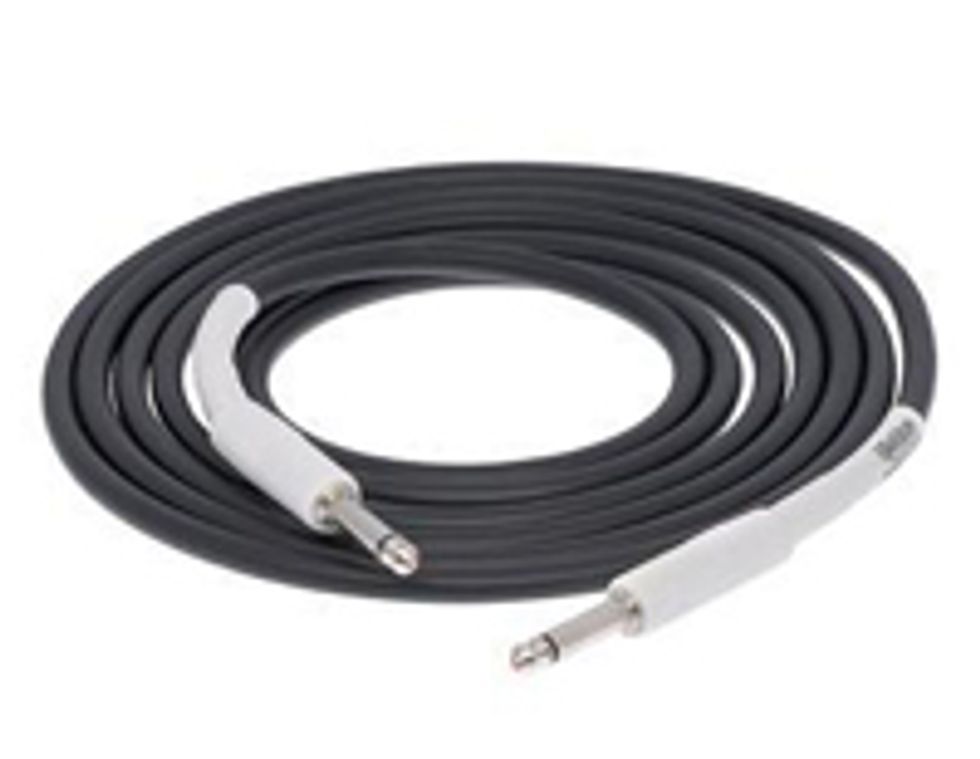
15’ oversized jacket with Kevlar core to prevent accidental stretching, G&H Showsaver plugs topped with white plastic strain relief.
Bob says: I heard a bit more bottom from this cable, but still a nice spectrum, with good detail. Not quite as punchy as the previous cable. Its handling was more what I am used to with good flexibility and weight making it easy to coil. The construction features the same double strain relief and Kevlar core with a single stranded conductor and in this case a spiral shield; hence the flexibility.
Dan says: Like the other Pro Co Lifeline cable I tried, this model has a full-frequency sound, with a great bottom and plenty of detail. Excellent transient response, too. The jacket is thick yet flexible, if a bit heavy. Great double strain relief system. This cable is an excellent value for both sound and durability.
| Planet Waves |
| Bob’s overview: A member of the D’Addario family of products, these cables uphold a quality tradition while targeting buyers who are looking for innovative designs. Some of Planet Waves’ innovations include a built in cable wrap, and a unique grounding system using both foil and copper braid or spiral. Their warranty is lifetime for manufacturing defects. |
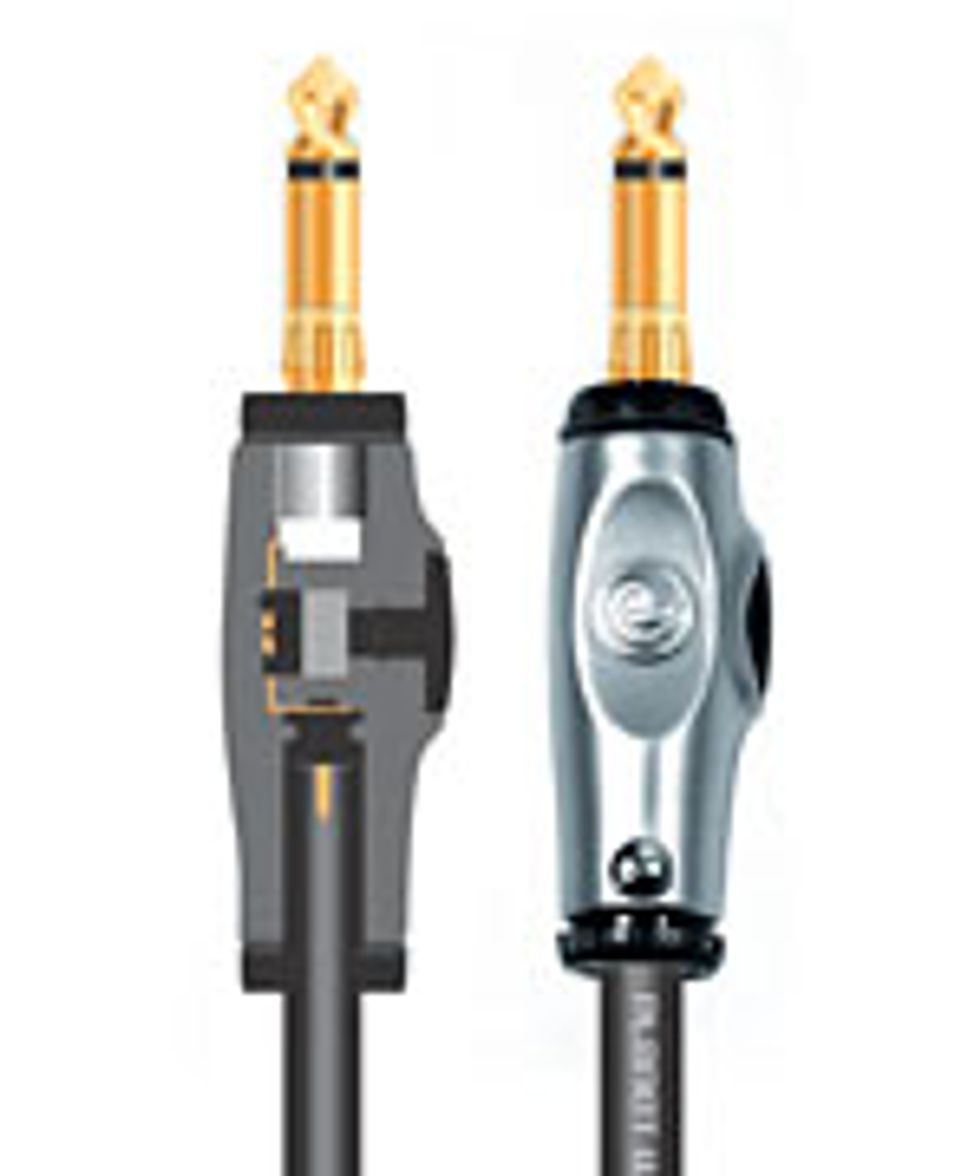
20’ cable with ultra-fine stranded copper conductor with foil shield and braided outer conductor insulation made from conductive PVC. Gold-plated plugs with a switched shorting plug on one end. There''s also an incredibly handy elastic cord tie.
Bob says: The Circuit Breaker cable is a very nice bright sounding cable with very good detail. Its main innovation is an on/off switch at the guitar end to allow buzz free instrument changes. It also has double shielding and thus handles a bit stiffly. I was unable to open the proprietary plug and cannot really comment on the strain relief.
Dan says: What a handy cable for doubling without an A/B box! Just push in the switch and swap axes. This cable had a tight, clear sound on my Jazz Bass, but was less full in the lows than I’d like. Well-focused sound. The cable is of medium thickness, yet a bit stiff. The plugs on the Circuit Breaker look really sturdy, but I’d prefer to see some strain relief heat-shrink coming out to beef up the connection.
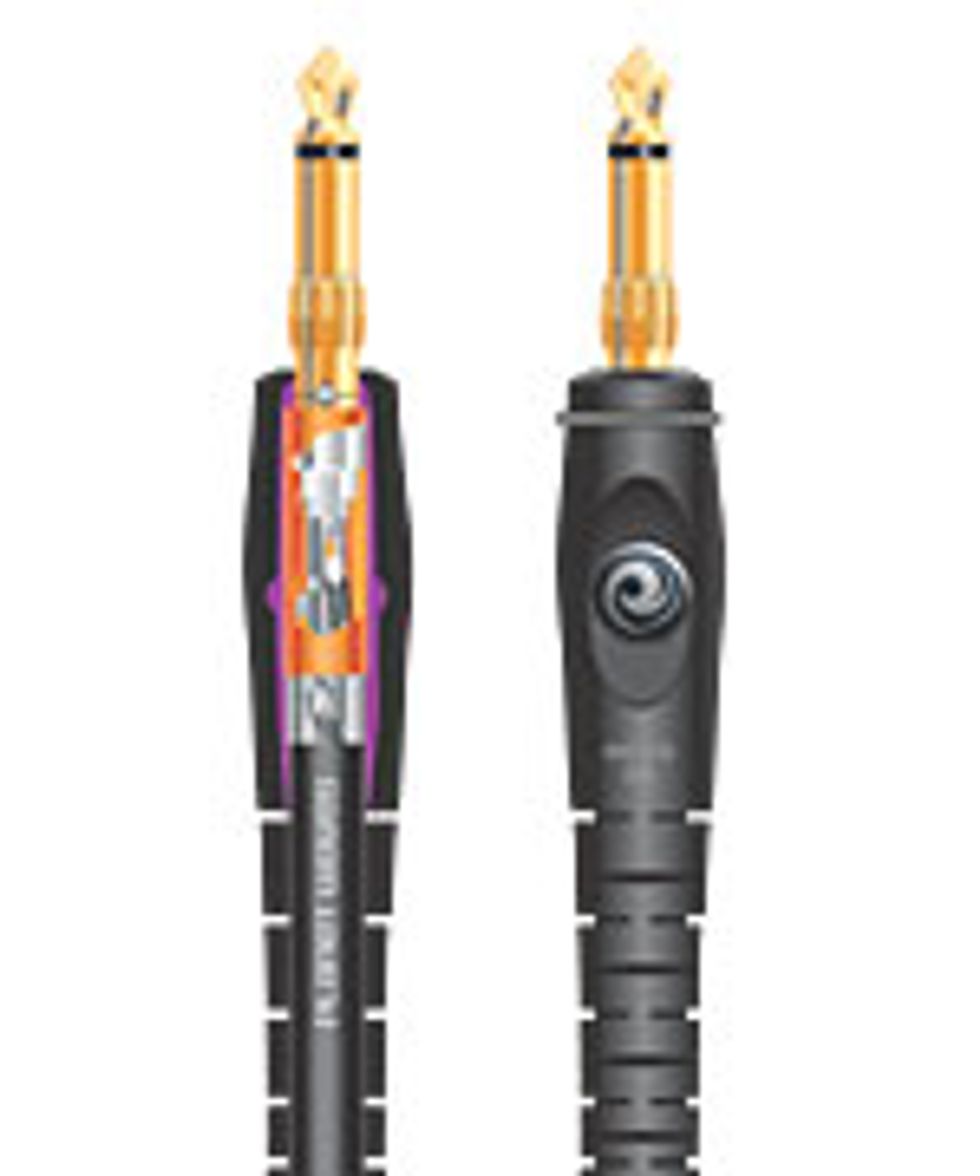
20’ cable with twisted pair copper conductors, foil shield topped by braided shield and polymer jacket. Gold-plated plug with encapsulated soldering points, copper shielding tube and molded strain relief.
Bob says: The Custom series cable is bright and punchy with a slightly hyped midrange. It uses a twisted pair of center conductors and double shielding with molded heavy duty plugs and strain relief at both ends to make it an on-stage workhorse. It is also just a tad on the stiff side.
Dan says: My Jazz Bass found this to be a full frequency cable with a warmer top than some. It has more mids than highs, but is very even sounding across the sound spectrum. The cable has nice flexibility and reasonable weight. Its big molded plugs seem sturdy and provide great strain relief. Another cable that should last for a long time.
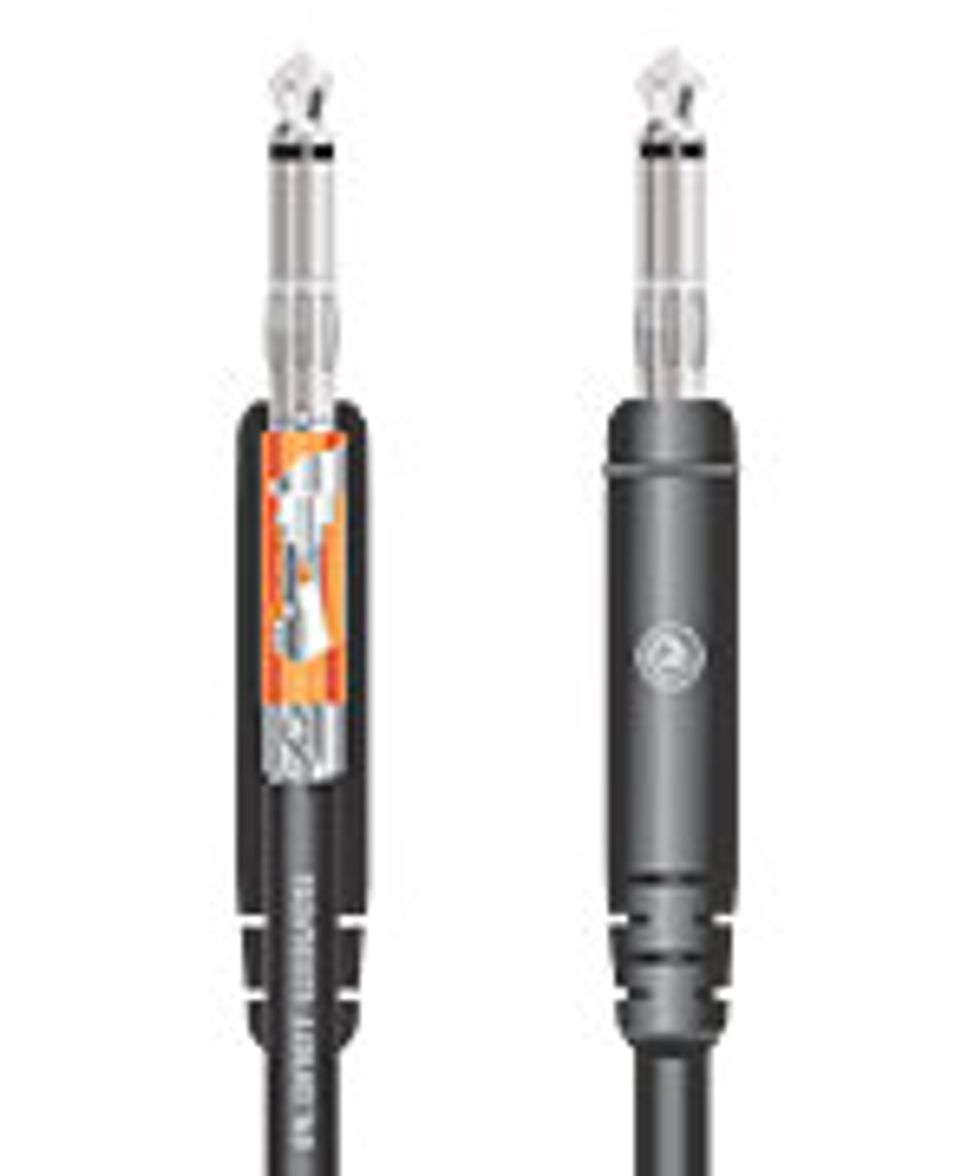
20’ single conductor cable with 90% spiral shield with molded connectors and nickel plated ends.
Bob says: The Classic series is a somewhat bright and airy sounding cable with more traditional coaxial cable configuration. It is slightly thinner and is more flexible than its more expensive brethren.
Dan says: This one surprised me. It’s such an unassuming, basic cable but sounded great with my Jazz Bass. I heard a full-frequency tone, with good bottom – more so than the other Planet Waves cables – and a warm top end. This was another one of the lighter cables, thinner than many and the most flexible of all. The plugs are like a mini version of Planet Waves molded strain relief plugs. They should do the job, but I’d prefer the flexible part to be a bit longer to create a sturdier transition between cable and plug. Another excellent value that should last a long time.
| George L''s |
| Bob’s overview: The highly respected guitar and pedal steel innovator George L. Lewis has designed a “family” of cables based on high quality sound and easily replaceable connectors, thus allowing the user to customize his or her guitar rig to specific needs. The plug attachment system uses a sharp center spike which impales the center conductor while the set screw in the solid plug body engages the braided shield and compresses the cable in its socket to secure in place. |
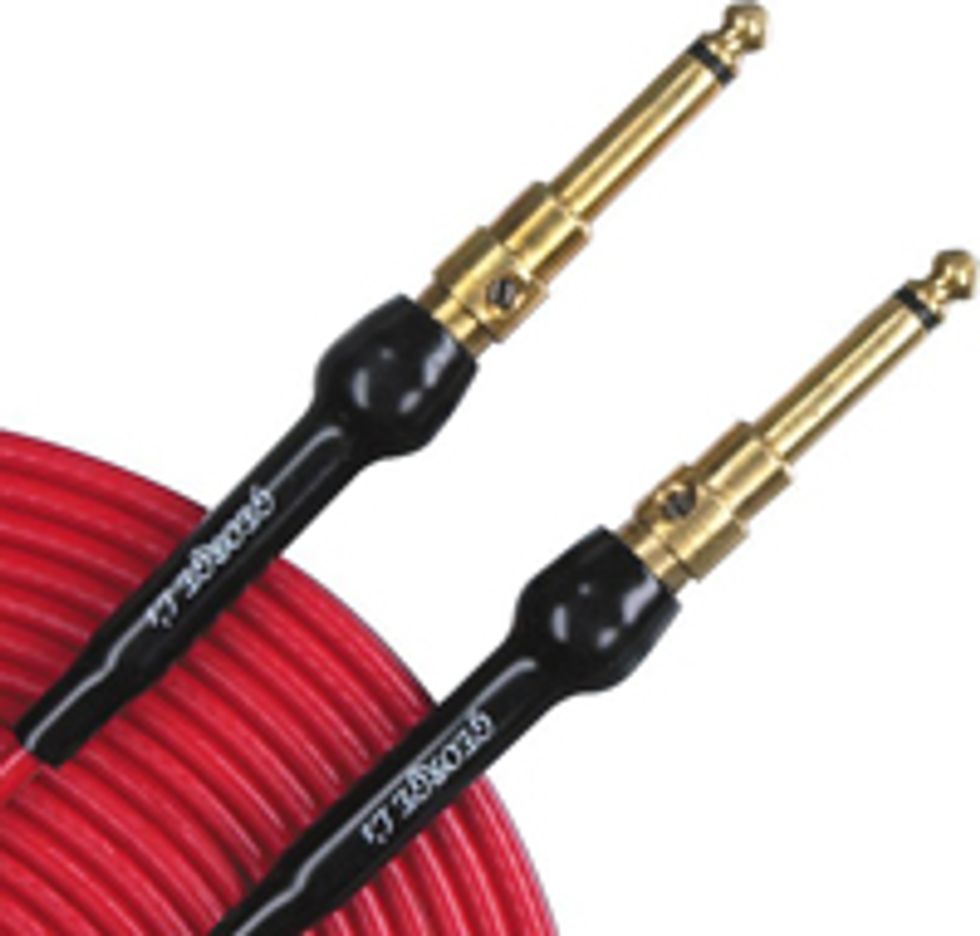
20’ cable with seven-strand copper core and tinned braided shield in black, red or blue, regular or stretch (extra long) solderless plugs and plastic slide-on strain relief.
Bob says: These cables have a full midrange with just a bit of extra top and good detail. The brass plug added a bit more top to the sound. The boot is easily slid back to expose the set screw thus not providing much support for straight pull cable strain. Handling characteristic are pretty good with the thin cable diameter compensating for the heavy duty braid. There is some feeling of inherent stiffness.
Dan says: This skinny cable has a tight sound with good detail. It’s another one with less on the bottom end…I prefer a fatter sounding cable, but the venerable George L’s would help out in boomy venues. By far, this is the lightest cable I’ve ever seen, yet it’s fairly stiff and tends to stay coiled on the floor. The gold plugs were just a bit warmer than the others. George L’s solderless cables are like a lizard that loses its tail when caught and can live to see another day. It took less than a minute to cut the cable and reinstall the end. I wish that the slide-on plastic strain relief jackets would stay put once installed – I kept sliding them up the cord when unplugging.
| Mogami |
| Bob’s overview: The Mogami Gold series cable is a very, very good sounding cable which uses quality of cable design, materials, and manufacture to achieve its strong presence in the cable market. Mogami pro audio cable is found in many of the best recording studios in the world. |
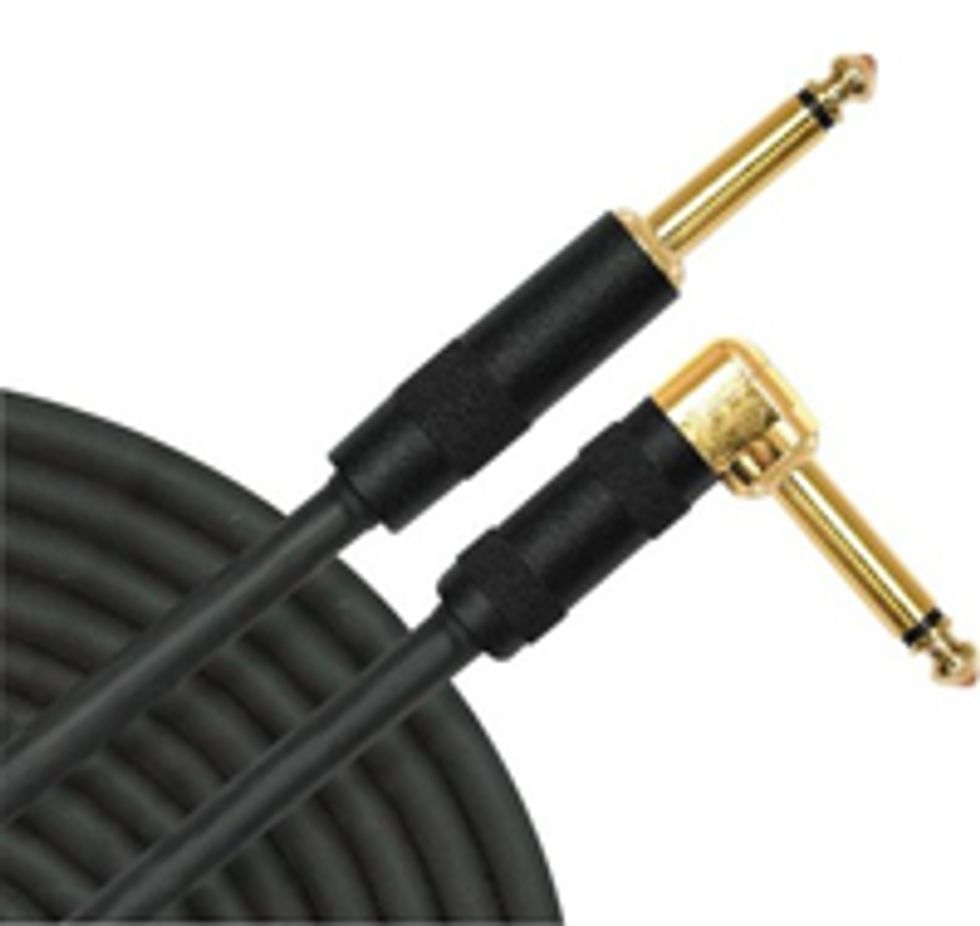
18’ cable with stranded copper core, carbon conductive polymer subshield, ultra-high density spiral copper shield, G&H plugs with heat-shrink strain relief.
Bob says: The sound is evenly balanced across the spectrum with excellent detail and a sweet top end. A very fine tight spiral wrap shield and a special high strand count 20 gauge center conductor “under the hood” give this cable its powerful sound. G&H connectors and moderate strain relief round out the build of this fine product. The handling characteristics are very good.
Dan says: This cable has great transient response and excellent detail with clear highs. This cable’s sound is lighter on the low end than many, which slappers will appreciate. For my fingerstyle blues gigs, I’d prefer a fuller bottom end. This cable has one of the thinner jackets which makes for a bit lighter weight. I was surprised to find this cable to be just a bit stiff, but it’s certainly not a problem. Because I play two basses at most gigs, I’m swapping back and forth via an A/B pedal and prefer a cable with a bit more strain relief than this one.
Wrapping ‘em Up, Looking Ahead
So there you have it, the foundation for cable design and a look at seven cables that put design factors into action. This batch has done a good job of showing you the basics of what you can expect, adding a few nice touches along the way.
Recall what we said at the start – once you get past the parameters of quality cable design, there is no best cable. Sure, we had a few favorites, but your favorites might be different. What somebody calls a clear-sounding cable might be overly-bright to another player. In all, how a cable interacts with your guitar and your amp creates distinct sonic differences. And for some of you, a cable must look marvelous and sound marvelous, too.
Keep in mind what you’ve learned here about cables and their design, because the second part of this article will take you on an adventure to see how designers stretch the boundaries of convention. You’ll read about some different choices of conductor materials and more elaborate types of shielding. We’ll keep our focus on those same factors – design, sound, durability, handling – plus some prices that might surprise you. In all, you’ll learn about nine more cables from eight manufacturers, with prices starting over $75 and ranging up to $180.
Until then, go back to your gig bag. See what guitar cables are lurking within. Give those cables a listen. Think about what you’ve been getting by with all these years while serving up your hard-earned scratch for guitars and amps in the relentless pursuit of tone. Read part two here!| 5/14 Addendum: High End, Schmigh End Editor''s Note: As you can see in the comments section at the bottom of this page, high end cables, let alone how one goes about reviewing them, constitute an area of our industry in which there are as many different opinions as there are design options. With so many different styles of music, guitars and rigs as well as varying degrees of player experience, taste and ability to physically hear the same frequencies, it’s no wonder that the topic can quickly stir up a flame war. From square one, our goal has been to submit to you what we’ve learned about cable technology, as well as some of our own opinions of how certain cables sound. When people start agreeing on classic debates such as Strat vs. Paul, we’ll start believing there’s a “best” cable or a “best way” to review them. Our hope is that you’ll jump into the fray and post your own $.02. Keep an eye out for more pieces about cables and cable manufacturers in the future. If there’s one thing we’ve learned from your feedback, it’s that cables really matter to a lot of you and in very different ways. Please check Part Two of this series for a look at a number of higher-end cables that many people prefer. And for those of you who swear that high dollar cables are basically hogwash for the gigging musician who competes with bar chatter and poor room acoustics, we defend your right to hold that position. In fact, there’s a very familiar cable company, Whirlwind Music Distributors, that suggests as much. As a final addendum to Part One of our Cable Roundup, we’d like to share their approach with you as well as Dan and Bob’s thoughts on their cables. |
| Whirlwind |
| About the Cables: Classic Series, Leader Elite, and Leader Standard in 15’ length, MRSP $19.49 to $25.94 |
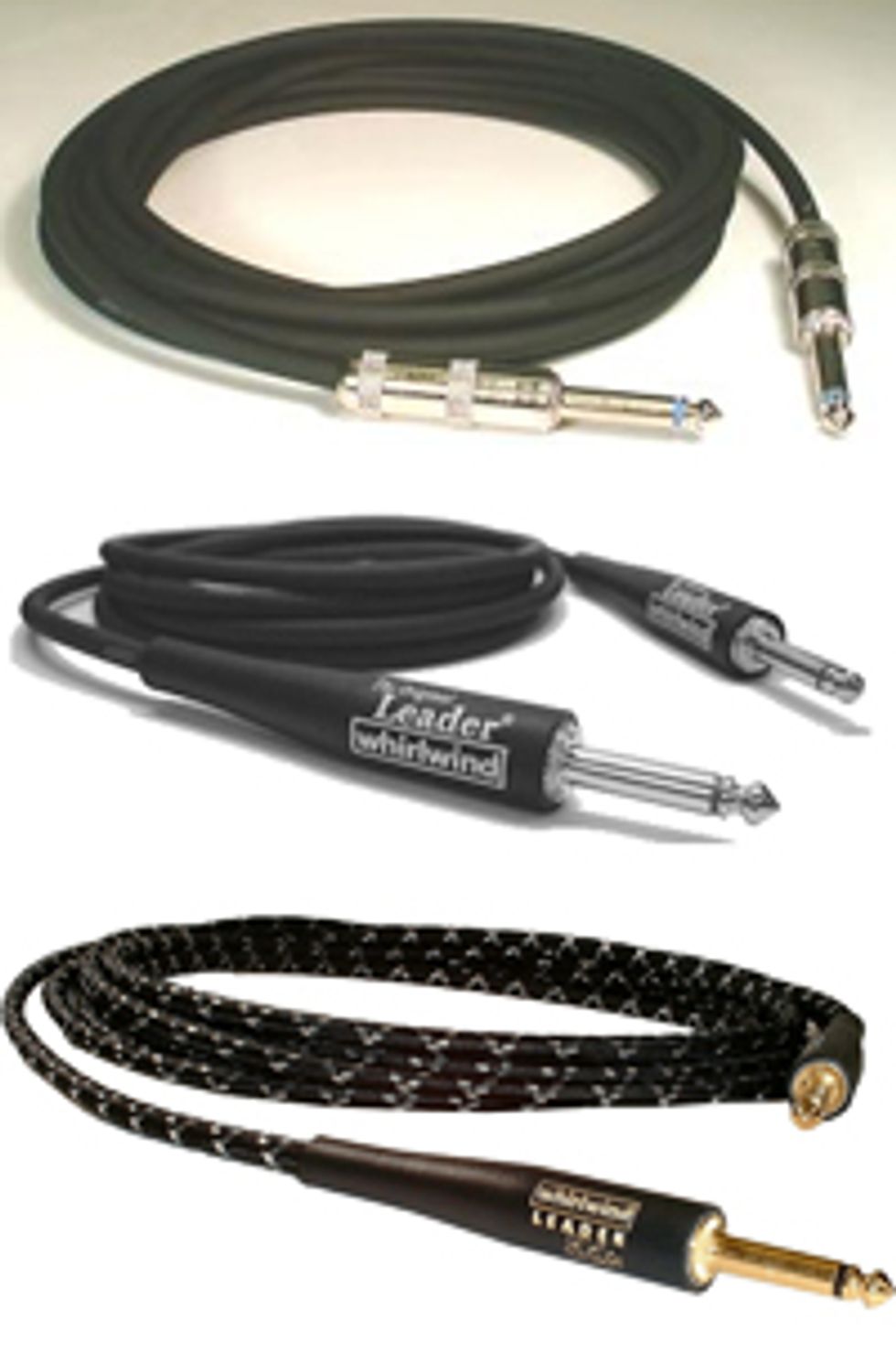 Top to bottom: Whirlwind Classic Series, Leader Standard and Leader Elite |
“When the NAMM folks saw these cables, they were an instant hit and Michael left the show with orders for thousands of cables,” says Al Keltz, Whirlwind’s general manager.
Over the years, Whirlwind has followed a basic philosophy in designing its cables. “It’s pretty simple,” Keltz explains. “Build pro-quality cables that perform day in and day out, charge what you must to make a profit but keep it honest and reasonable.”
Keltz asserts that there are “quite a few cable companies out there that make outrageous, misinformed and sometimes intentionally misleading claims regarding mysterious properties of electronics and physics in an attempt to justify turning what should be a $35 cable into a $135 profit generator.”
He believes that the construction of Whirlwind’s Accusonic +1 cable and Leader Elite gold-plated plugs accomplish just what a player needs. “What more could anyone possibly do to a cable and connector to justify such an outrageous leap in price?” Keltz asks. “I suppose we could do the same but we choose to fool none of the people none of the time.”
Keltz acknowledges that he offers a different perspective to cable design. “I absolutely agree that cables can and do have some effect on frequency response, but unless the cable capacitance or inductance is extremely high, the effect will be subtle. These subtle differences also become much less noticeable when you fire up the whole band and all sorts of sounds start interacting with each other on stage due to room resonances and comb filtering.”
If subtle sonic differences can’t be noticed in many gigging situations, what would then guide the choice of guitar cable? “That’s when durability becomes much more important than a frequency nuance that can no longer be perceived,” Keltz explains.
Dan says: The Classic Cord, Leader, and Leader Elite cables are three variations on a theme. They all share the same basic cable, so they all sound the same: a mid-centered voice, nicely defined, but a bit shy on the bottom end. These cables are a bit thinner and lighter than many we''ve tested.
The Elite, with braided black/silver cloth on the outside, is the stiffest and tends to coil up on the floor. It’s a bit flashy. The Leader is more flexible, as is the Classic, since their cable is the same.
The Elite and Leader both share rubber strain relief jackets that slide over the plug. They''re not heat-shrink material, so they protect against serious bending, but don''t help much if the cable is tugged. That part of strain relief is accomplished by a plastic chuck that slides over the connections and tightens onto the cable when the outside sleeve is screwed on. This combination of strain relief strategies should do a good job of providing a long life for the Leader and Elite. The Classic, in contrast, relies completely on the plug''s crimp-on tabs for strain relief, along with a healthy dose of solder flowed nicely over the plug''s connections - strictly old school there.
Bob says: I agree with Dan, but would like to add a bit of support to the Whirlwind position that in most gigging situations, ie. a loud band in an acoustically-challenged venue with a noisy crowd, the subtle sonic advantages of "high end" cables will not be heard.
A former non-believer myself, I must admit that in certain situations; such as hearing the stage mix through a high quality in-ear monitor system, or in the studio or a quiet venue with the audience hanging on each note, I would not be without a premium cable.

























